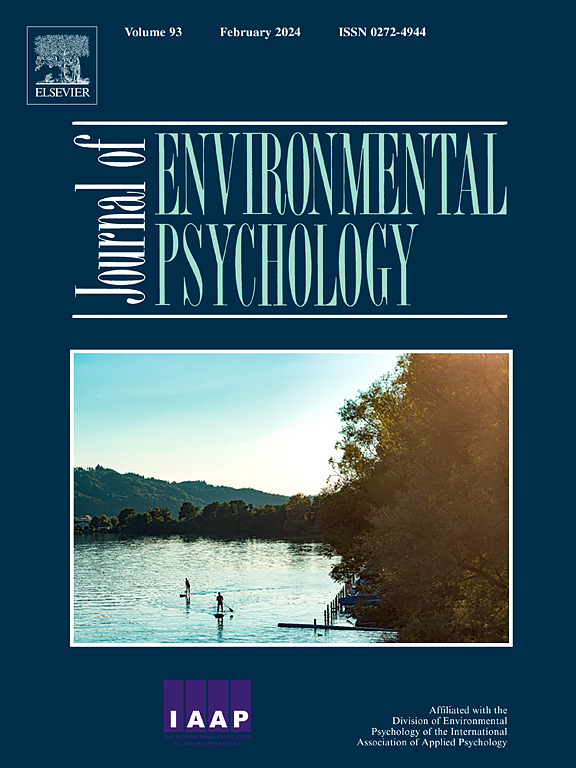The impact of color correlated temperature and illuminance levels of office lighting on stress and cognitive restoration
IF 6.1
1区 心理学
Q1 ENVIRONMENTAL STUDIES
引用次数: 0
Abstract
In modern workplaces, the well-being and productivity of employees are increasingly recognized as essential for organizational success. This study explores the impact of lighting interventions—specifically, Correlated Color Temperature (CCT) and illumination intensity—on stress and cognitive function restoration among office workers. A between-subjects experimental design involving 100 participants assessed the effects of various lighting conditions on stress responses and cognitive performance after exposure to stress-inducing and cognitive fatigue tasks. Five experimental conditions were studied: 100 lux & 7000 K, 100 lux & 3000 K, 1000 lux & 7000 K, 1000 lux & 3000 K, and a baseline condition of 500 lux at 3700 K. Results indicated that lighting conditions significantly influence both physiological stress markers (such as skin conductance level and heart rate) and cognitive performance. Specifically, warm, and dimmed lighting (3000 K, 100 lux) effectively reduced stress markers and perceived stress levels, aligning with theories suggesting the calming effects of warmer white light tones. Conversely, cooler lighting (7000 K) was associated with enhanced cognitive performance and reduced cognitive fatigue, potentially due to its similarity to natural daylight, stimulating an alert state conducive to mental tasks. These findings suggest that lighting interventions offer a non-intrusive strategy to improve well-being and productivity in office environments, particularly addressing acute symptoms.
办公室照明颜色相关温度和照度对压力和认知恢复的影响
在现代工作场所,员工的幸福感和生产力越来越被认为是组织成功的关键。本研究探讨了照明干预,特别是相关色温(CCT)和照明强度对上班族压力和认知功能恢复的影响。一项涉及100名参与者的受试者间实验设计评估了不同照明条件对压力诱发和认知疲劳任务后应激反应和认知表现的影响。研究了5种实验条件:100勒克斯&安培;7000 K, 100 lux &;3000k, 1000lux &;7000 K, 1000 lux &;3000k, 3700k时基线条件为500lux。结果表明,光照条件对生理应激指标(如皮肤电导水平和心率)和认知表现均有显著影响。具体来说,温暖和昏暗的照明(3000 K, 100勒克斯)有效地降低了压力标记和感知压力水平,这与温暖的白光色调具有镇静作用的理论一致。相反,较冷的照明(7000 K)与增强认知能力和减少认知疲劳有关,这可能是由于它与自然光相似,刺激有利于脑力任务的警觉状态。这些发现表明,照明干预提供了一种非侵入性的策略,可以改善办公环境中的幸福感和工作效率,特别是在解决急性症状方面。
本文章由计算机程序翻译,如有差异,请以英文原文为准。
求助全文
约1分钟内获得全文
求助全文
来源期刊

Journal of Environmental Psychology
Multiple-
CiteScore
10.60
自引率
8.70%
发文量
140
审稿时长
62 days
期刊介绍:
The Journal of Environmental Psychology is the premier journal in the field, serving individuals in a wide range of disciplines who have an interest in the scientific study of the transactions and interrelationships between people and their surroundings (including built, social, natural and virtual environments, the use and abuse of nature and natural resources, and sustainability-related behavior). The journal publishes internationally contributed empirical studies and reviews of research on these topics that advance new insights. As an important forum for the field, the journal publishes some of the most influential papers in the discipline that reflect the scientific development of environmental psychology. Contributions on theoretical, methodological, and practical aspects of all human-environment interactions are welcome, along with innovative or interdisciplinary approaches that have a psychological emphasis. Research areas include: •Psychological and behavioral aspects of people and nature •Cognitive mapping, spatial cognition and wayfinding •Ecological consequences of human actions •Theories of place, place attachment, and place identity •Environmental risks and hazards: perception, behavior, and management •Perception and evaluation of buildings and natural landscapes •Effects of physical and natural settings on human cognition and health •Theories of proenvironmental behavior, norms, attitudes, and personality •Psychology of sustainability and climate change •Psychological aspects of resource management and crises •Social use of space: crowding, privacy, territoriality, personal space •Design of, and experiences related to, the physical aspects of workplaces, schools, residences, public buildings and public space
 求助内容:
求助内容: 应助结果提醒方式:
应助结果提醒方式:


